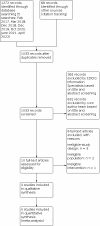Interventions for preventing and reducing the use of physical restraints of older people in general hospital settings
- PMID: 36004796
- PMCID: PMC9404383
- DOI: 10.1002/14651858.CD012476.pub2
Interventions for preventing and reducing the use of physical restraints of older people in general hospital settings
Abstract
Background: Physical restraints, such as bedrails, belts in chairs or beds, and fixed tables, are commonly used for older people in general hospital settings. Reasons given for using physical restraints are to prevent falls and fall-related injuries, to control challenging behavior (such as agitation or wandering), and to ensure the delivery of medical treatments. Clear evidence of their effectiveness is lacking, and potential harms are recognised, including injuries associated with the use of physical restraints and a negative impact on people's well-being. There are widespread recommendations that their use should be reduced or eliminated.
Objectives: To assess the best evidence for the effects and safety of interventions aimed at preventing and reducing the use of physical restraint of older people in general hospital settings. To describe the content, components and processes of these interventions.
Search methods: We searched the Cochrane Dementia and Cognitive Improvement Group's register, MEDLINE (Ovid SP), Embase (Ovid SP), PsycINFO (Ovid SP), CINAHL (EBSCOhost), Web of Science Core Collection (Clarivate), LILACS (BIREME), ClinicalTrials.gov and the World Health Organization's meta-register the International Clinical Trials Registry Portal on 20 April 2022.
Selection criteria: We included randomised controlled trials and controlled clinical trials that investigated the effects of interventions that aimed to prevent or reduce the use of physical restraints in general hospital settings. Eligible settings were acute care and rehabilitation wards. We excluded emergency departments, intensive care and psychiatric units, as well as the use of restrictive measures for penal reasons (e.g. prisoners in general medical wards). We included studies with a mean age of study participants of at least 65 years. Control groups received usual care or active control interventions that were ineligible for inclusion as experimental interventions.
Data collection and analysis: Two review authors independently selected the articles for inclusion, extracted data, and assessed the risk of bias of all included studies. Data were unsuitable for meta-analysis, and we reported results narratively. We used GRADE methods to describe our certainty in the results.
Main results: We included four studies: two randomised controlled trials (one individually-randomised, parallel-group trial and one clustered, stepped-wedge trial) and two controlled clinical trials (both with a clustered design). One study was conducted in general medical wards in Canada and three studies were conducted in rehabilitation hospitals in Hong Kong. A total of 1709 participants were included in three studies; in the fourth study the number of participants was not reported. The mean age ranged from 67 years to 84 years. The duration of follow-up covered the period of patients' hospitalisation in one study (21 days average length of stay) and ranged from 4 to 11 months in the other studies. The definition of physical restraints differed slightly, and one study did not include bedrails. Three studies investigated organisational interventions aimed at implementing a least-restraint policy to reduce physical restraints. The theoretical approach of the interventions and the content of the educational components was comparable across studies. The fourth study investigated the use of pressure sensors for participants with an increased falls risk, which gave an alarm if the participant left the bed or chair. Control groups in all studies received usual care. Three studies were at high risk of selection bias and risk of detection bias was unclear in all studies. Because of very low-certainty evidence, we are uncertain about the effect of organisational interventions aimed at implementing a least-restraint policy on our primary efficacy outcome: the use of physical restraints in general hospital settings. One study found an increase in the number of participants with at least one physical restraint in the intervention and control groups, one study found a small reduction in both groups, and in the third study (the stepped-wedge study), the number of participants with at least one physical restraint decreased in all clusters after implementation of the intervention but no detailed information was reported. For the use of bed or chair pressure sensor alarms for people with an increased fall risk, we found moderate-certainty evidence of little to no effect of the intervention on the number of participants with at least one physical restraint compared with usual care. None of the studies systematically assessed adverse events related to use of physical restraint use, e.g. direct injuries, or reported such events. We are uncertain about the effect of organisational interventions aimed at implementing a least-restraint policy on the number of participants with at least one fall (very low-certainty evidence), and there was no evidence that organisational interventions or the use of bed or chair pressure sensor alarms for people with an increased fall risk reduce the number of falls (low-certainty evidence from one study each). None of the studies reported fall-related injuries. We found low-certainty evidence that organisational interventions may result in little to no difference in functioning (including mobility), and moderate-certainty evidence that the use of bed or chair pressure sensor alarms has little to no effect on mobility. We are uncertain about the effect of organisational interventions on the use of psychotropic medication; one study found no difference in the prescription of psychotropic medication. We are uncertain about the effect of organisational interventions on nurses' attitudes and knowledge about the use of physical restraints (very low-certainty evidence).
Authors' conclusions: We are uncertain whether organisational interventions aimed at implementing a least-restraint policy can reduce physical restraints in general hospital settings. The use of pressure sensor alarms in beds or chairs for people with an increased fall risk has probably little to no effect on the use of physical restraints. Because of the small number of studies and the study limitations, the results should be interpreted with caution. Further research on effective strategies to implement a least-restraint policy and to overcome barriers to physical restraint reduction in general hospital settings is needed.
Copyright © 2022 The Cochrane Collaboration. Published by John Wiley & Sons, Ltd.
Conflict of interest statement
Jens Abraham: none known
Julian Hirt: none known
Christin Richter: none known
Sascha Köpke: none known
Gabriele Meyer: none known
Ralph Möhler: none known
Figures






Update of
- doi: 10.1002/14651858.CD012476
References
References to studies included in this review
Enns 2014 {published data only}
-
- Enns E, Rhemtulla R, Ewa V, Fruetel K, Holroyd-Leduc JM. A controlled quality improvement trial to reduce the use of physical restraints in older hospitalized adults. Journal of the American Geriatrics Society 2014;62(3):541-5. - PubMed
Kwok 2006 {published data only}
-
- Kwok T, Mok F, Chien WT, Tam E. Does access to bed-chair pressure sensors reduce physical restraint use in the rehabilitative care setting. Journal of Clinical Nursing 2006;15(5):581-7. - PubMed
Lai 2011 {published data only}
-
- Lai CK, Chow SK, Suen LK, Wong IY. Reduction of physical restraints on patients during hospitalisation/rehabilitation: a clinical trial. Asian Journal of Gerontology & Geriatrics 2013;8:38-43.
Wong 2020 {published data only}
-
- Wong, CH. Effects of a physical restraint reduction program on restraint prevalence, restraint proportion, fall number and nurses' knowledge, attitude and practice on physical restraint use. Dissertation Abstracts International Section A: Humanities and Social Sciences 2020;81(9-A):27783980.
References to studies excluded from this review
Boustani 2012 {published data only}
Huang 2009 {published data only}
-
- Huang HT, Chuang YH, Chiang KF. Nurses' physical restraint knowledge, attitudes, and practices: the effectiveness of an in-service education program. Journal of Nursing Research 2009;17(4):241-8. - PubMed
Lüdecke 2020 {published data only}
-
- Lüdecke D, Kofahl C. Use of sedating medication and physical restraints for patients with dementia in acute care hospitals: a non-randomized case control study [Einsatz von sedierenden Medikamenten und bewegungseinschränkenden Maßnahmen bei Patienten mit Demenz im Akutkrankenhaus: eine nichtrandomisierte Fall-Kontroll-Studie]. Zeitschrift für Gerontologie und Geriatrie 2020;53(2):138-44. - PMC - PubMed
Mion 2001 {published data only}
-
- Mion LC, Fogel J, Sandhu S, Palmer RM, Minnick AF, Cranston T, et al. Outcomes following physical restraint reduction programs in two acute care hospitals. Joint Commission Journal on Quality Improvement 2001;27(11):605-18. - PubMed
Shorr 2012 {published data only}
Steinert 2009 {published data only}
-
- Steinert T, Bohnet U, Flammer E, Lüchtenberg D, Eisele F. Effects of a training of power and balance on the use of mechanical restraint among in-patients with dementia [Effekte eines Kraft- und Bewegungstrainings auf die Fixierungshäufigkeit bei Demenzpatienten in der stationären gerontopsychiatrischen Versorgung]. Psychiatrische Praxis 2009;36(6):273-8. - PubMed
Additional references
AAN 2015
-
- American Academy of Nursing. American Academy of Nursing announced engagement in National Choosing Wisely Campaign. Nursing Outlook 2015;63(1):96-8. - PubMed
Abbott 2021
Abraham 2019
-
- Abraham J, Kupfer R, Behncke A, Berger-Höger B, Icks A, Haastert B, et al. Implementation of a multicomponent intervention to prevent physical restraints in nursing homes (IMPRINT): a pragmatic cluster randomized controlled trial. International Journal of Nursing Studies 2019;96:27-34. - PubMed
Abraham 2020
-
- Abraham J, Hirt J, Kamm F, Möhler R. Interventions to reduce physical restraints in general hospital settings: a scoping review of components and characteristics. Journal of Clinical Nursing 2020;29(17-18):3183-200. - PubMed
Abraham 2021
-
- Abraham J, Bake M, Berger-Höger B, Köpke S, Kupfer R, Meyer G, et al. Process evaluation of a multicomponent intervention to prevent physical restraints in nursing homes (IMPRINT): a mixed methods study. Journal of Advanced Nursing 2021;77(3):1465-77. - PubMed
AHRQ 2013
-
- Agency for Healthcare Research and Quality . Preventing falls in hospitals. A toolkit for improving quality of care. Available at www.ahrq.gov/sites/default/files/publications2/files/fallpxtoolkit-updat... 2013.
Bleijlevens 2016
-
- Bleijlevens MH, Wagner LM, Capezuti E, Hamers JP, International Physical Restraint Workgroup. Physical restraints: consensus of a research definition using a modified Delphi technique. Journal of the American Geriatrics Society 2016;64(11):2307-10. - PubMed
Bretschneider 2012
-
- Bretschneider W. Restraint in hospitals - a sore point [Fixierungsmaßnahmen in Krankenhäusern – Ein wunder Punkt]. Gesundheitswesen 2012;74(12):812-7. - PubMed
Campbell 2020
Chou 2020
-
- Chou MY, Hsu YH, Wang YC, Chu CS, Liao MC, Liang CK, et al. The adverse effects of physical restraint use among older adult patients admitted to the internal medicine wards: a hospital-based retrospective cohort study. The Journal of Nutrition, Health & Aging 2020;24(2):160-5. - PubMed
Chow 2007
-
- Chow SK, Lai CK, Wong TK, Suen LK, Kong SK, Chan CK, et al. Evaluation of the Morse Fall Scale: applicability in Chinese hospital populations. International Journal of Nursing Studies 2007;44(4):556-65. - PubMed
Cleary 2015
-
- Cleary KK, Prescott K. The use of physical restraints in acute and long-term care: an updated review of the evidence, regulations, ethics, and legality. Journal of Acute Care Physical Therapy 2015;6(1):8-15.
Cortés 2021
Craig 2008
Crutchfield 2019
-
- Crutchfield P, Gibb TS, Redinger MJ, Ferman D, Livingstone J. The conditions for ethical application of restraints. Chest 2019;155(3):617-25. - PubMed
da Silva 2012
-
- da Silva PS, Fonseca MC. Unplanned endotracheal extubations in the intensive care unit: systematic review, critical appraisal, and evidence-based recommendations. Anesthesia & Analgesia 2012;114(5):1003-14. - PubMed
de Casterlé 2015
-
- Casterlé BD, Goethals S, Gastmans C. Contextual influences on nurses' decision-making in cases of physical restraint. Nursing Ethics 2015;22(6):642-51. - PubMed
de Vries 2004
-
- Vries OJ, Ligthart GJ, Nikolaus T, European Academy of Medicine of Ageing-Course III. Differences in period prevalence of the use of physical restraints in elderly inpatients of European hospitals and nursing homes. Journals of Gerontology. Series A, Biological Sciences and Medical Sciences 2004;59(9):M922-3. - PubMed
Dichter 2019
-
- Dichter MN, Reuther S, Trutschel D, Köpke S, Halek M. Organizational interventions for promoting person-centred care for people with dementia. Cochrane Database of Systematic Reviews 2019, Issue 7. Art. No: CD013375. [DOI: 10.1002/14651858.CD013375] - DOI
EQUATOR Network 2022
-
- EQUATOR Network. CONSORT 2010 Statement: updated guidelines for reporting parallel group randomised trials. www.equator-network.org/reporting-guidelines/consort (accessed 3 June 2022).
Evans 2002
-
- Evans D, Fitzgerald M. The experience of physical restraint: a systematic review of qualitative research. Contemporary Nurse 2002;13(2-3):126-35. - PubMed
Evans 2003
-
- Evans D, Wood J, Lambert L. Patient injury and physical restraint devices: a systematic review. Journal of Advanced Nursing 2003;41(3):274-82. - PubMed
Fariña‐López 2018
-
- Fariña-López E, Estévez-Guerra GJ, Polo-Luque ML, Hanzeliková Pogrányivá A, Penelo E. Physical restraint use with elderly patients: perceptions of nurses and nursing assistants in spanish acute care hospitals. Nursing Research 2018;67(1):55-9. - PubMed
Fazio 2018
-
- Fazio S, Pace D, Maslow K, Zimmerman S, Kallmyer B. Alzheimer’s Association dementia care practice recommendations. Gerontologist 2018;58:S1eS9. - PubMed
Gastmann 2006
Goethals 2012
-
- Goethals S, Dierckx de Casterlé B, Gastmans C. Nurses’ decision-making in cases of physical restraint: a synthesis of qualitative evidence. Journal of Advanced Nursing 2012;68(8):1198-210. - PubMed
Goethals 2013
-
- Goethals S, Dierckx de Casterlé B, Gastmans C. Nurses' ethical reasoning in cases of physical restraint in acute elderly care: a qualitative study. Medicine, Health Care and Philosophy 2013;16(4):983-91. - PubMed
Gulpers 2011
-
- Gulpers MJ, Bleijlevens MH, Ambergen T, Capezuti E, Rossum E, Hamers JP. Belt restraint reduction in nursing homes: effects of a multicomponent intervention program. Journal of the American Geriatrics Society 2011;59(11):2029-36. - PubMed
Guyatt 2011
-
- Guyatt G, Oxman AD, Akl EA, Kunz R, Vist G, Brozek J, et al. GRADE guidelines: 1. Introduction-GRADE evidence profiles and summary of findings tables. Journal of Clinical Epidemiology 2011;64(4):383–94. - PubMed
Handley 2017
Healey 2008
-
- Healey F, Oliver D, Milne A, Connelly JB. The effect of bedrails on falls and injury: a systematic review of clinical studies. Age and Ageing 2008;37(4):368-78. - PubMed
Healey 2009
-
- Healey FM, Cronberg A, Oliver D. Bedrail use in English and Welsh hospitals. Journal of the American Geriatrics Society 2009;57(10):1887-91. - PubMed
Heinze 2012
-
- Heinze C, Dassen T, Grittner U. Use of physical restraints in nursing homes and hospitals and related factors: a cross-sectional study. Journal of Clinical Nursing 2012;21(7-8):1033-40. - PubMed
Hendlmeier 2019
Higgins 2017
-
- Higgins JP, Altman DG, Sterne JA, editor(s). Chapter 8: Assessing risk of bias in included studies. In: Higgins JP, Churchill R, Chandler J, Cumpston MS, editor(s), Cochrane Handbook for Systematic Reviews of Interventions version 5.2.0 (updated June 2017), Cochrane, 2017. Available from www.training.cochrane.org/handbook/archive/v5.2.
Higgins 2019
-
- Higgins JP, Thomas J, Chandler J, Cumpston M, Li T, Page MJ, Welch VA, editor(s). Cochrane Handbook for Systematic Reviews of Interventions Version 6.2 (updated February 2021). Cochrane, 2021. Available from www.training.cochrane.org/handbook. - PMC - PubMed
Hoffmann 2014
-
- Hoffmann TC, Glasziou PP, Boutron I, Milne R, Perera R, Moher D, et al. Better reporting of interventions: template for intervention description and replication (TIDieR) checklist and guide. BMJ 2014;348:g1687. - PubMed
Hung 2017
IPA 2015
-
- International Psychogeriatric Association. Complete guides to behavioral and psychological symptoms of dementia. Module 5. Non-pharmacological treatments; 2015. Available at: sites.psu.edu/eit4bpsd/files/2017/12/IPA_BPSD_Module_5_2015_Final-1ho5ep....
Jutkowitz 2016
-
- Jutkowitz E, Brasure M, Fuchs E, Shippee T, Kane RA, Fink HA, et al. Care-delivery interventions to manage agitation and aggression in dementia nursing home and assisted living residents: a systematic review and meta-analysis. Journal of the American Geriatrics Society 2016;64(3):477-88. - PubMed
Kikkas 2013
-
- Kiekkas P, Aretha D, Panteli E, Baltopoulos GI, Filos KS. Unplanned extubation in critically ill adults: clinical review. Nursing in Critical Care 2013;18(3):123-34. - PubMed
Köpke 2012
-
- Köpke S, Mühlhauser I, Gerlach A, Haut A, Haastert B, Möhler R, et al. Effect of a guideline-based multicomponent intervention on use of physical restraints in nursing homes: a randomized controlled trial. JAMA 2012;207(20):2177-84. - PubMed
Krüger 2013
-
- Krüger C, Mayer H, Haastert B, Meyer G. Use of physical restraints in acute hospitals in Germany: a multi-centre cross-sectional study. International Journal of Nursing Studies 2013;50(12):1599-606. - PubMed
Kwok 2012
-
- Kwok T, Bai X, Chui MY, Lai CK, Ho DW, Ho FK, et al. Effect of physical restraint reduction on older patients' hospital length of stay. Journal of the American Medical Directors Association 2012;13(7):645-50. - PubMed
Lach 2016
-
- Lach HW, Leach KM, Butcher HK. Evidence-based practice guideline: changing the practice of physical restraint use in acute care. Journal of Gerontological Nursing 2016;42(2):17-26. - PubMed
Leung 2007
-
- Leung SO, Chan CC, Shah S. Development of a Chinese version of the Modified Barthel Index-validity and reliability. Clinical Rehabilitation 2007;21(10):912-22. - PubMed
Lin 2009
-
- Lin LC, Wu SC, Kao CC, Tzeng YL, Watson R, Tang SH. Single ability among activities of daily living as a predictor of agitation. Journal of Clinical Nursing 2009;18(1):117-23. - PubMed
Mahoney 1965
-
- Mahoney FI, Barthel DW. Functional evaluation: the Barthel index. Maryland State Medical Journal 1965;14:61-5. - PubMed
Minnick 2007
-
- Minnick AF, Mion LC, Johnson ME, Catrambone C, Leipzig R. Prevalence and variation of physical restraint use in acute care settings in the US. Journal of Nursing Scholarship 2007;39(1):30-7. - PubMed
Möhler 2012
-
- Möhler R, Richter T, Köpke S, Meyer G. Interventions for preventing and reducing the use of physical restraints in long-term geriatric care - a Cochrane review. Journal of Clinical Nursing 2012;21(21-22):3070-81. - PubMed
Möhler 2014
-
- Möhler R, Meyer G. Attitudes of nurses towards the use of physical restraints in geriatric care: a systematic review of qualitative and quantitative studies. International Journal of Nursing Studies 2014;51(2):274-88. - PubMed
Möhler 2015
Mott 2005
-
- Mott S, Poole J, Kenrick M. Physical and chemical restraints in acute care: their potential impact on the rehabilitation of older people. International Journal of Nursing Practice 2005;11(3):95-101. - PubMed
NICE 2018
-
- National Institute for Health and Care Excellence. Dementia: assessment, management and support for people living with dementia and their carers. NICE Clinical Guidelines; 2018. Available at www.nice.org.uk/guidance/ng97. - PubMed
O'Cathain 2019
O'Flatharta 2014
-
- O'Flatharta T, Haugh J, Robinson SM, O'Keeffe ST. Prevalence and predictors of bedrail use in an acute hospital. Age and Ageing 2014;43(6):801-5. - PubMed
Park 2007
-
- Park M, Tang JH, Adams S, Titler MG. Evidence-based guideline: changing the practice of physical restraint use in acute care. Journal of Gerontological Nursing 2007;33(2):9-16. - PubMed
RCN 2008
-
- Royal College of Nursing. Let’s talk about restraint. Rights, risks and responsibility; 2008. Available at restraintreductionnetwork.org/wp-content/uploads/2016/11/Lets-talk-about....
Reilly 2019
-
- Reilly JC, Houghton C. The experiences and perceptions of care in acute settings for patients living with dementia: A qualitative evidence synthesis. International Journal of Nursing Studies 2019;96:82-90. - PubMed
RevMan Web 2022 [Computer program]
-
- Review Manager Web (RevMan Web). Version 4.12.0. The Cochrane Collaboration, 2022. Available at revman.cochrane.org.
RNOA 2012
-
- Registered Nurses’ Association of Ontario. Promoting safety: alternative approaches to the use of restraints; 2012. Available at rnao.ca/sites/rnao-ca/files/Promoting_Safety_-_Alternative_Approaches_to....
Scherder 2010
-
- Scherder EJ, Bogen T, Eggermont LH, Hamers JP, Swaab DF. The more physical inactivity, the more agitation in dementia. International Psychogeriatrics 2010;22(8):1203-8. - PubMed
Skivington 2021
Suen 1999
-
- Suen LK. Knowledge, attitude and practice of nursing home staff towards physicalrestraints in Hong Kong nursing homes. Asian Journal of Nursing Studies 1999;5(2):73-86.
Sze 2012
-
- Sze TW, Leng CY, Lin SK. The effectiveness of physical restraints in reducing falls among adults in acute care hospitals and nursing homes: a systematic review. Joanna Briggs Institute Database of Systematic Reviews 2012;10:307–51. - PubMed
Thomann 2021a
-
- Thomann S, Zwakhalen S, Richter D, Bauer S, Hahn S. Restraint use in the acute-care hospital setting: a cross-sectional multi-centre study. International Journal of Nursing Studies 2021;114:103807. - PubMed
References to other published versions of this review
Möhler 2016
-
- Möhler R, Nürnberger C, Abraham J, Köpke S, Meyer G. Interventions for preventing and reducing the use of physical restraints of older people in general hospital settings. Cochrane Database of Systematic Reviews 2016, Issue 12. Art. No: CD012476. [DOI: 10.1002/14651858.CD012476] - DOI - PMC - PubMed
Publication types
MeSH terms
LinkOut - more resources
Full Text Sources
Miscellaneous

